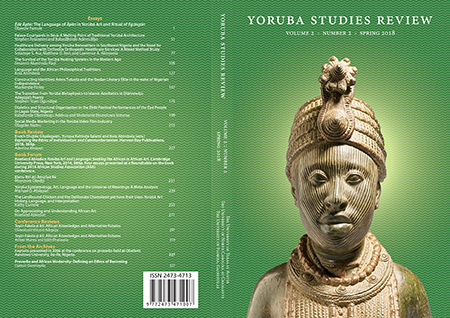Writing: Reviews & Think Pieces
Yoruba Studies Review, 2(2), 2019

The spring volume of Yoruba Studies Review volume 2 (2) is out. Yoruba Studies Review is a refereed biannual journal dedicated to the study of the experience of the Yoruba peoples and their descendants globally. The journal covers all aspects of the Yoruba transnational, national, and regional presence, both in their West African homeland and in diasporic spaces, past and present. The journal embraces all disciplines in the humanities, social sciences, and the basic/applied sciences in as much as the focus is on the Yoruba affairs and the intersections with other communities and practices worldwide. It is jointly published by University of Texas at Austin, University of North Carolina at Charlotte, University of Florida, and American Associations of Teachers of Yoruba
One of the articles in this new volume “Palace Courtyards in Ilesa: A Melting Point Of Traditional Yoruba Architecture” is jointly written by Dr. Stephen F?laranmi a Post-Doctoral Fellow with the NRF SARChI Chair, Arts of Africa and Global Souths research programme headed by Prof Ruth Simbao at the Department of Fine Arts, Rhodes University, South Africa, and Dr. Babasehinde Ademuleya. F?laranmi and Ademuleya are both of the Department of Fine and Applied Arts, Obafemi Awolowo University, Ile-Ife, Nigeria.
The paper examines the courtyards in the palace of certain chiefs and the ?wa Obokun of Ilesa in South-west Nigeria. The courtyard is an important space in traditional Yoruba architecture that has not received adequate scholarly attention. The paper therefore identified ten courtyards in the palace of the ?wa, four in the Rísawe palace, and two in the palaces of Lejoka and Odole of Ilesa. These courtyards are used as models for courtyards in Yoruba architecture. Findings revealed that most of the courtyards in the ?wa palace are generally not used for one specific function, though some are used mainly for religious purposes. The courtyards in the palaces of the chiefs are more functional, and better maintained than those of the Owa‘s palace. The paper concludes that considering their ancient and social functions- the courtyards form a convergence function and relevance in traditional Yoruba architecture. A space where all within the home find relevant for domestic, social and religious functions, the paper suggests that efforts be made to ensure that existing courtyards are designated as landmarks architecture and properly cared for to serve as tourist destination.
Folaranmi, S.A. and Ademuleya, B.A. 2018. “Palace Courtyards in Ilesa: A Melting Point of Traditional Yoruba Architecture”. Yoruba Studies Review, 2 (2): 51-76 University of Texas at Austin, University of North Carolina at Charlotte, University of Florida, and American Associations of Teachers of Yoruba.
Dr. Stephen Folaranmi is a Post-Doctoral Fellow with the NRF/DST SARChI Chair Geopolitics and the Arts of Africa, Arts of Africa and Global Souths research programme headed by Prof Ruth Simbao at the Department of Fine Arts, Rhodes University, South Africa, and Lecturer in the Department of Fine and Applied Arts, Obafemi Awolowo University, Ile-Ife, Nigeria.
Last Modified: Mon, 11 Feb 2019 10:20:44 SAST
